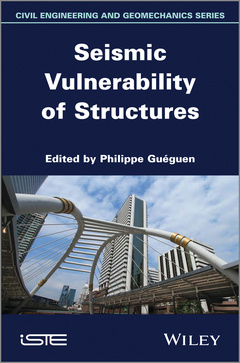Description
Seismic Vulnerability of Structures
Author: Gueguen Philippe
Language: English
Subject for Seismic Vulnerability of Structures:
Keywords
introduction; philippe; seismic; buildings; application; approaches; sergio; observational; urban; vulnerability; mechanical; classification; models; scale; scenario; territorial; implementation; curves; fragility; methods
368 p. · 16.8x23.9 cm · Hardback
Description
/li>Contents
/li>Biography
/li>
This book is focused on the seismic vulnerability assessment methods, applied to existing buildings, describing several behaviors and new approaches for assessment on a large scale (urban area).
It is clear that the majority of urban centers are composed of old buildings, designed according to concepts and rules that are inadequate to the seismic context. How to assess the vulnerability of existing buildings is an essential step to improve the management of seismic risk and its prevention policy. After some key reminders, this book describes seismic vulnerability methods applied to a large number of structures (buildings and bridges) in moderate (France, Switzerland) and strong seismic prone regions (Italy, Greece).
Contents
1. Seismic Vulnerability of Existing Buildings: Observational and Mechanical Approaches for Application in Urban Areas, Sergio Lagomarsino and Serena Cattari.
2. Mechanical Methods: Fragility Curves and Pushover Analysis, Caterina Negulescu and Pierre Gehl.
3. Seismic Vulnerability and Loss Assessment for Buildings in Greece, Andreas J. Kappos.
4. Experimental Method: Contribution of Ambient Vibration Recordings to the Vulnerability Assessment, Clotaire Michel and Philippe Guéguen.
5. Numerical Model: Simplified Strategies for Vulnerability Seismic Assessment of Existing Structures, Cédric Desprez, Panagiotis Kotronis and Stéphane Grange.
6. Approach Based on the Risk Used in Switzerland, Pierino Lestuzzi.
7. Preliminary Evaluation of the Seismic Vulnerability of Existing Bridges, Denis Davi.
About the Authors
Philippe Guéguen is a Senior IFSTTAR Researcher at ISTerre, Joseph Fourier University Grenoble 1, France
Introduction xi
Philippe GUEGUEN
Chapter 1. Seismic Vulnerability of Existing
Buildings: Observational and Mechanical Approaches for Application in Urban Areas 1
Sergio LAGOMARSINO and Serena CATTARI
1.1. Introduction 1
1.2. Damage levels and building types classification 8
1.3. The macroseismic approach 12
1.4. The mechanical approach 21
1.4.1. Masonry buildings 24
1.4.2. Reinforced concrete buildings 37
1.5. Implementation of models for scenario analysis at territorial scale 52
1.6. Final remarks 57
1.7. Bibliography 57
Chapter 2. Mechanical Methods: Fragility Curves and Pushover Analysis 63
Caterina NEGULESCU and Pierre GEHL
2.1. Introduction 63
2.2. Pushover analysis 64
2.2.1. What is pushover analysis? 64
2.2.2. How to calculate (or construct) a pushover curve? 65
2.2.3. Critical aspects in the construction (or calculation) of a pushover curve 72
2.2.4. Hypotheses and developments 73
2.2.5. Evaluation of the target displacement and the performance point (PP) 77
2.3. The fragility curves 83
2.3.1. From deterministic evaluation to fragility functions 83
2.3.2. The “indirect” methods based on the capacity curve . 89
2.3.3. “Direct” methods 94
2.3.4. Toward multivariate fragility functions 98
2.4. Conclusions 100
2.5. Bibliography 101
Chapter 3. Seismic Vulnerability and Loss Assessment for Buildings in Greece 111
Andreas J. KAPPOS
3.1. Introduction 111
3.2. Vulnerability assessment of RC buildings 113
3.2.1. Buildings analyzed 113
3.2.2. Inelastic analysis procedure 115
3.2.3. Estimation of economic loss using inelastic dynamic analysis 117
3.2.4. Development of pushover and capacity curves 119
3.2.5. Derivation of fragility curves 124
3.2.6. Fragility curves in terms of Sd 131
3.3. Vulnerability assessment of URM buildings 133
3.3.1. Overview of the methodology adopted 133
3.3.2. Purely empirical approach 133
3.3.3. Nonlinear analysis and capacity curves 136
3.3.4. Hybrid fragility curves 140
3.4. Region-specific fragility curves 144
3.5. Development of earthquake scenarios 147
3.6. Concluding remarks 153
3.7. Acknowledgments 155
3.8. Bibliography 156
Chapter 4. Experimental Method: Contribution of Ambient Vibration Recordings to the Vulnerability Assessment 161
Clotaire MICHEL and Philippe GUEGUEN
4.1. Introduction 161
4.2. Recordings and analysis of vibrations in structures 163
4.2.1. Historical background 163
4.2.2. Stability and temporal variation of the vibrations 169
4.2.3. Analysis of recordings 172
4.3. Observation of vibration of buildings and seismic design 176
4.3.1. Case of the common building in mainland France 176
4.3.2. Experimental data and vulnerability models 181
4.4. Modeling existing structures with the help of experimental data 183
4.4.1. Modal model 183
4.4.2. Validation using the buildings of Grenoble 184
4.5. Application to the study of vulnerability at a large scale 187
4.5.1. Fragility curves and uncertainties 187
4.5.2. Application in Grenoble 190
4.6. Limitations and outlook 196
4.6.1. Nonlinear behavior 196
4.6.2. Soil–strutcture interaction 198
4.7. Conclusions 199
4.8. Acknowledgments 202
4.9. Bibliography 202
Chapter 5. Numerical Model: Simplified Strategies for Vulnerability Seismic Assessment of Existing Structures 213
Cédric DESPREZ, Panagiotis KOTRONIS and Stéphane GRANGE
5.1. Introduction 213
5.2. Case study 216
5.2.1. Presentation of the structure 216
5.2.2. Spatial discretization 217
5.2.3. Constitutive laws 219
5.2.4. Validation of the numerical model 219
5.2.5. Assessment of the seismic vulnerability (dynamic simulations) 223
5.2.6. Estimation of the seismic vulnerability using pushover analysis 232
5.3. Conclusions 238
5.4. Caution 240
5.5. Acknowledgments 240
5.6. Bibliography 240
Chapter 6. Approach Based on the Risk Used in Switzerland 249
Pierino LESTUZZI
6.1. Introduction 249
6.2. Earthquake in the Swiss SIA construction codes 249
6.2.1. Seismic hazard 250
6.2.2. New and existing: different approaches 254
6.2.3. Existing: approach based on risk 255
6.3. Examples: masonry buildings 272
6.3.1. Analysis method and assumptions 273
6.3.2. Isolated building of three stories 275
6.3.3. Seven-story “bar-shaped” building 278
6.4. Bibliography. 285
Chapter 7. Preliminary Evaluation of the Seismic Vulnerability of Existing Bridges 287
Denis DAVI
7.1. Introduction 287
7.2. Experimental feedback from past earthquakes 288
7.2.1. Seismic behavior of bridges and main reasons for failure 288
7.2.2. The approaches for vulnerability evaluation developed abroad 298
7.3. The SISMOA method for the preliminary evaluation of the seismic vulnerability of bridges adapted to the French context 307
7.3.1. General context 307
7.3.2. Presentation of the calibration method 311
7.3.3. Calculation of the risk indexes and use of the results 322
7.3.4. Examples of application 325
7.4. Conclusions 334
7.5. Bibliography 335
7.6. List of acronyms 337
List of Authors 339
Index 341
Philippe Gueguen is Senior Researcher; ISTerre; IFSTTAR/CNRS/IRD/UdS; Université.
Joseph Fourier, Grenoble 1, France.

